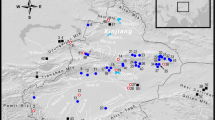Abstract
This study, based on environmental archaeological studies focused on Qin’an County and Li County in Gansu Province, China, shows that during 8–7.3 ka BP few cultivated crop seeds were found. After 6.4 ka BP, during the Banpo period, many crop seeds appeared, indicating the development of agriculture. Millet agriculture in this area appeared and flourished a little later than in the Central Plain of China. Climate change is an important factor that influenced the development of agriculture in this area. The rapid expansion of agriculture during late Yangshao and Changshan benefited from the humid and warm climate in the mid-Holocene, especially the emergence of rice. After 4 ka BP, climate became drier, and agriculture began to decline. So Siwa Culture is characterized by pastoral economy, until the Eastern Zhou period, agriculture began to recover, when wheat and barley appeared in Li County, indicating diversification of agriculture of this time.
Similar content being viewed by others
References
Diamond J. Evolution, consequences and future of plant and animal domestication. Nature, 2002, 418: 700–707
Denham T, Haberle S, Lentfer C. New evidence and revised interpretations of early agriculture in Highland New Guinea. Antiquity, 2004, 78: 839–857
An Z M. The prehistoric agriculture of China (in Chinese). Acta Archaeol Sin, 1988, 4: 369–381
Crawford G W. The transitions to agriculture in Japan. In: Gebauer A B, Price T D, eds. Transitions to Agriculture in Prehistory, Monographs in World Archaeology. Madison: Prehistory Press, 1992. 117–132
Underhill P A, Passarino G, Lin A A, et al. The hylogeography of Y chromosome binary haplotypes and the origins of modern human populations. Ann Hum Genet, 2001, 65: 43–62
Yan W M. The Origin of Agriculture and Civilization (in Chinese). Beijing: Science Press, 2000. 1–180
Zhao Z J. Discussion of the origin of dry land agriculture in northern China based on the result of flotation in Xinglongwa site. In: Department of Relics and Museology of Nanjing Normal University, eds. Antiquity of East Asia (in Chinese). Beijing: Culture and Relics Press, 2004. 188–199
Chen W H. About Agricultural Archaeology (in Chinese). Nanchang: Jiangxi Education Press, 1988. 3–121
Shi X B. The ecological characteristics of Xiachuan Culture and its relationship with the origin of foxtail millet agriculture (in Chinese). Archaeol Cultural Relics, 2000, 4: 17–35
Liu C J, Kong Z C. The morphological comparison of foxtail millet and common millet and its use in archaeological identification (in Chinese). Archaeol, 2004, 8: 76–83
Hattersley P W. δ 13C Value of C4 types in grasses. Aust J Plant Physiol, 1982, 9: 139–154
Schulze E D, Ellis R, Schulze W, et al. Diversity, metabolic types and δ 13C carbon isotope ratios in the grass flora of Namibia in relation to growth form, precipitation and habitat conditions. Oecologia, 1996, 106: 352–369
Lang S D. The site settlement patterns and their evolution in Dadiwan site, Gansu (in Chinese). Archaeol, 2003, 6: 83–89
An C B, Feng Z D, Tang L Y. Environment change and cultural response between 8000 and 4000 cal. yr BP in the western Loess Plateau, NW China. J Quat Sci, 2004, 19: 529–535
An C B, Tang L Y, Barton L, et al. Climatic change and cultural response around 4,000 cal. yr BP in the western part of the Chinese Loess Plateau. Quat Res, 2005, 63: 347–352
Joint Archeology Team of the Early Qin Culture. A report of the survey of Neolithic site of the upper reaches of the Xihan River (in Chinese). Archaeol Cul Relics, 2004, 6: 3–12
Liu C J, Kong Z C, Lang S D. The agricultural plant remains of the Dadiwan site and human living environment (in Chinese). Heritage Central Plain, 2004, 4: 26–30
Shui T. Papers on the Bronze Age Archaeology of the Northwest China (in Chinese). Beijing: Science Press, 2001. 147–153
Shui T. Papers on the Bronze Age Archaeology of the Northwest China (in Chinese). Beijing: Science Press, 2001. 110–114
An C B, Feng Z D, Barton L. Dry or Humid? Mid-Holocene Humidity Changes in arid and semiarid China. Quat Sci Rev, 2006, 25: 351–361
Author information
Authors and Affiliations
Corresponding author
About this article
Cite this article
An, C., Ji, D., Chen, F. et al. Evolution of prehistoric agriculture in central Gansu Province, China: A case study in Qin’an and Li County. Chin. Sci. Bull. 55, 1925–1930 (2010). https://doi.org/10.1007/s11434-010-3208-2
Received:
Accepted:
Published:
Issue Date:
DOI: https://doi.org/10.1007/s11434-010-3208-2




